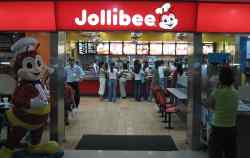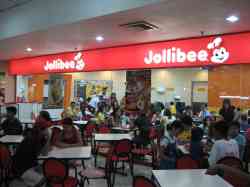 Tony Tan Caktiong’s Jollibee has been one of the most admired, most copied, most innovative and most professionally-run company here in the Philippines. It has been the number one fastfood chain overtaking giants such as Mc Donalds and Kentucky Fried Chicken or KFC.
Tony Tan Caktiong’s Jollibee has been one of the most admired, most copied, most innovative and most professionally-run company here in the Philippines. It has been the number one fastfood chain overtaking giants such as Mc Donalds and Kentucky Fried Chicken or KFC.How did a local jolly red bee knocked down a multinational red-haired clown named Ronald? Let’s see another inspiring story of the founder of one of my ideal businesses. With its success, a Jollibee franchise has now a tag price of P25+ Million (US$ 500,000+). Wow!
Tony Tan Caktiong’s Life and his Jollibee company is another rags to riches story of an entrepreneur that truly inspires everyone. Tony was the third of seven siblings born to poor parents who migrated from the Fujian province in China to look for a better life here in the Philippines. His father began as a chef in a Chinese Temple. Not later on his father was invited to open a restaurant business in Davao so the whole family moved south. All together, they helped one another in managing the restaurant business which in turn became profitable. This allowed young Tony to return back to Manila and pursue his course Chemical Engineering at the University of Santo Tomas (UST).
In 1975, Tony and his colleagues went on a visit to a Magnolia Ice Cream plant located in Quezon City and learned that it was offering franchise when he saw a poster for it. By the month of May, with his family savings, he took P350,000 to grab the franchise opportunity and opened two Magnolia ice cream parlors named Cubao Ice Cream House located near the Coronet Theater, and Quiapo Ice Cream House located beside the bridge – the one going to ilalim – near a Mercury Drug outlet. They all worked hands-on but as the business propels, they noticed they could not do it all so they started to set up an organization hired store managers, and trained people.
Tony started with just two ice cream. Then after two years, he offered chicken and hamburger sandwiches, because customers were telling them they didn’t want to be eating ice cream all the time. They prepared the food in the back kitchen, and soon noticed that people were lining up more for hamburgers than for ice cream. Then in 1978, when they already had six ice cream parlors, they asked themselves: “Why don’t we change into a hamburger house?”
That was also the time they decided to incorporate and realized thet they needed a brand name. They were looking for a symbol that would represent the group, and because Tony was very impressed with Disneyland characters, they decided on a bee. The bee is a busy creature that produces honey – one of life’s sweetest things. They thought it would be a very good symbol to represent everybody. They decided they would all be very busy and happy at the same time, because if they were busy but not happy, it wouldn’t be worth it. That’s why they put the word jolly and just changed the “y” into “i” to form a brand name - JOLLIBEE.
“It wasn’t long before we heard that the multinationals were coming in – including McDonald’s. Friends started asking us if we were going to get a McDonald’s franchise but I remember saying, if you franchise, you can’t grow outside the Philippines”, says Tony.
McDonald’s came in 1982, but they didn’t feel threatened because they were a little naïve and Jollibee was doing very well. They found McDonald’s to be very good at everything, but it didn’t know the local culture. They knew the Filipino’s taste buds and what he liked in food, so they offered him flavorful and good-tasting products. He likes pasta, so they started offering spaghetti. He likes chicken, so they came up with good fried chicken by mixing different flavors. They also knew something important all along: Filipino taste is sweet. This is very Filipino – very Asian. He said: “If we eat anything sweet; we don’t really think it’s sweet; but try giving it to a foreigner and they’d be surprised.”


Tony narrates: “Filipinos also like to smell their food before they eat it. They want to be sure it smells delicious before they take a bite. Sometimes they would open a kettle and say, what’s this? It smells good! This was proved by the Langhap-Sarap advertising campaign by Basic [Footcone and Belding]. They did it for us initially for the hamburger, and when it became successful, we started using it as a campaign slogan for the other products.”
It didn’t take them long to introduce new products when they were starting out. The family members would discuss what new products customers would like, and without much marketing they’d bring something out – like spaghetti. Tony’s sister is also a good cook, so she would come up with a new recipe, they would comment on it, and then she’d fix the recipe before they started offering it. “Before, it was simple. Now, there’s a formal structure. There’s a big Research and Development (R&D) department and a marketing department. The marketing department gets inputs from customers and the products they like, and then communicate that to R&D. R&D then develops it. We have an internal taste panel that taste the food and comment on it, and when a formulation is needed they do it. The next step is a consumer panel test. We have the product taste-tested by consumers, and if it’s okay, we test the product in a few stores. Before it was easy, but now it takes three to six months to roll out a new product. Another time-consuming process is training our people on how to prepare and serve the new product.” says Tony.
Jollibee group has also become bigger. Now they have Chowking, Greenwich, Delifrance, and the recently acquired Red Ribbon. Greenwich pizza started as an over-the-counter pizza store at the Greenhills Shopping Center in San Juan, Metro Manila, in 1971. One time, the founder approached Tony to ask if they were interested – at that time she has 50 kiosks and having difficulty managing the business – when she asked them if they were interested, Tony said, “why not? Let’s form a joint venture.” They took over the management in 1994, but they retained the taste of her products because it suits the local market. On the other hand, they took over Chowking in 2000 because Chinese food is also very popular among Filipinos, but there was no good company serving the market. So they took over and worked on it.
“Delifrance is doing so-so. And the reason is because we’re still not used to eating bread as a meal – therefore, the market is limited to the AB classes. It can’t grow into a mass-market type. Our latest acquisition was Red Ribbon Bakeshop last 2005 to include cakes, rolls, breads and pastries in their line of products. For us to sustain a good growth rate on a long-term basis, we have to continue acquiring businesses”, Tony relates.
They had to let go of Binggo. They found that the convenience store was in a totally different industry. At one time, they had around 20 stores, but they found it hard supplying them because the volume they were buying for them was just too small to attract good suppliers. They had to let it go.
They’re also bullish on China because they’ve acquired Yonghe King and its 91 stores. “It’s making money. So there’s no pressure to turn it around; the challenge is how to expand the brand. China is huge; it’s like having several countries in one country. If we do well, we can have several thousand stores there. If Jollibee has more than 500 stores for 80 million Filipinos, how many stores can you put up for 1.3 Billion Chinese? Kentucky Fried Chicken alone is opening 200 stores a year in China. It’s doing very well”, says Tony.
“Many countries share our taste in food, and the opportunity is in going to China, India and Indonesia- countries with large populations. We usually do a very broad 10-year horizon but it’s not detailed. We have a five-year plan, a three-year plan, and a one-year plan. We have plans for China and India, but if we want to go to India, we’ll need a long-term plan. We might have to start putting Indian people into the organization and it would probably take at least three years before we sent them back. In China, we had an opportunity to break into the market with Yonghe, but because our people didn’t speak the language, we had to hire translators to help us out. We still send our people there, but they have to work with translators. We also need good people here. We’re lucky to be the leader, but it’s still a competitive market. You can’t afford mistakes because customers will leave if they’re not happy with you. The food business is still very basic. It’s still about taste. It’s still about How did you serve me? Is your place nice? Am I treated well? Do I get value? If you think about it, if we’re going out to eat, these are the basic things we look out for, but the execution is the difficult part. It’s not like other businesses where it’s the concept or the knowledge that’s difficult. Here, there’s no secret; it’s very easy, but it’s the execution that’s hard. If you ask a lot of restaurant, they know all these things. Executing day by day is what’s hard.”, Tony continues.
When asked what’s the secret of Jollibee’s success, Tony says: “If you have to ask, the secret of Jollibee’s success is sharing. We share our success with people; we give good compensation; we share any honor that comes our way. Actually, this idea of sharing didn’t come from me. It came from a friend. He said: You know why you’re successful? You know how to share. A lot of people do not share, but in Jollibee you share a lot with your people.”
Truly, Tony Tan Caktiong is another exemplar example of an inspiring entrepreneur. He had all the achievements from Management Man of the Year in 2002 to an Agora Award for Outstanding Marketing Achievement, from a Triple A Alumni Award from the Asian Institute of Management to a Ten Outstanding Young Men Award for Entrepreneurship. And to cap it all, he also won the World Entrepreneur of The Year 2004 by Ernst & Young besting other 31 world entrepreneur competitors.
On July 25, 2007, Jollibee Group launched Tio Pepe’s Karinderia in EDSA Central in Mandaluyong, it’s pilot restaurant to professionalize Filipino’s “Carinderia” Industry.
As of 2007, Jollibee had under its wing 1,385 stores in the country: Jollibee (583); Chowking (367); Greenwich (237); Red Ribbon (163); and Delifrance (35)
Overseas, Jollibee Group has 174 stores: Yonghe King in China (102); Jollibee in US (12); Red Ribbon in US (19); Chowking in US (12); Chowking in Dubai (7); Chowking in Indonesia (5); Jollibee in Other Countries (16) and one Chun Shui Tang, a teahouse in Taiwan.
Source: Excerpts from Go Negosyo and Entrepreneur Magazine.


No comments:
Post a Comment